Numerical Analysis of the Single-Directionally Misaligned Segment Behavior of Hydraulic TBM Tunnel
Abstract
:1. Introduction
2. 3D FEM for Numerical Analysis
2.1. Composition of Segment Lining
2.2. Composition of Segment Lining
2.3. Constitutive Relationships
2.4. Working Conditions
2.5. Analytical Locations of the Segment Lining
3. Results, Analysis and Discussion
3.1. Misaligned Crown Segment
3.1.1. Circumferential Stress of Segment
3.1.2. Segment Contact Stress
3.1.3. Stress of Locating Pins
3.2. Misaligned Invert Segment
3.2.1. Circumferential Stress of Segment
3.2.2. Segment Contact Stress
3.2.3. Stress of Locating Pins
4. Conclusions
Author Contributions
Funding
Data Availability Statement
Conflicts of Interest
References
- Li, X.; Cao, G.; Yao, G.; Yan, Z.; Ding, X.; Zhao, S. Optimization of anchor groove and its forming techniques with permanent formwork for prestressed concrete lining of high-pressure water conveyance tunnel. J. North China Univ. Water Resour. Electr. Power 2022, 43, 13–18. [Google Scholar]
- Wang, X.; Behbahani, S.; Iseley, T.; Azimi, M.; Wei, X.; Wei, G.; Shi, Y. Vertical tunneling in China—A case study of a hydraulic tunnel in Beihai. Tunn. Undergr. Space Technol. 2021, 107, 103650. [Google Scholar] [CrossRef]
- Deng, M.; Tan, Z. Study on boring indexes and key issues of tunnel boring machine cluster construction of super-long tunnels. Tunn. Constr. 2021, 41, 1809–1826. [Google Scholar]
- Sun, W.; Shi, M.; Zhang, C.; Zhao, J.; Song, X. Dynamic load prediction of tunnel boring machine (TBM) based on heterogeneous in-situ data. Autom. Constr. 2018, 92, 23–34. [Google Scholar] [CrossRef]
- Huang, X.; Liu, W.; Zhang, Z.; Zhuang, Q.; Zhu, Y.; Wang, Q.; Kwok, C.Y.; Wang, S. Structural behavior of segmental tunnel linings for a large stormwater storage tunnel: Insight from full-scale loading tests. Tunn. Undergr. Space Technol. 2020, 99, 103376. [Google Scholar] [CrossRef]
- Zhang, Z.; Wang, B.; Wang, X.; He, Y.; Wang, H.; Zhao, S. Safety risk assessment of TBM tunnel construction based on fuzzy evidence reasoning. Processes 2022, 10, 2597. [Google Scholar] [CrossRef]
- Su, A.; Wang, S.; He, C.; Lu, D.; Fang, R. Disease characteristics and causes analysis of segments of shield tunnels in composite stratum during construction. Chin. J. Geotech. Eng. 2019, 67, 683–692. [Google Scholar]
- Li, X.; Lin, X.; Zhu, H.; Wang, X.; Liu, Z. Condition assessment of shield tunnel using a new indicator: The tunnel serviceability index. Tunn. Undergr. Space Technol. 2017, 67, 98–106. [Google Scholar] [CrossRef]
- Yao, Z.; Xiong, Y.; Fu, L.; Quan, Y.; Niu, W.; Hu, L. Failure mechanism and support technology of surrounding rocks in lithologic interface area of deep-buried tunnel bored by tunnel boring machine. Tunn. Constr. 2023, 43, 102–111. [Google Scholar]
- Panji, M.; Mojtabazadeh-Hasanlouei, S. On subsurface box-shaped lined tunnel under incident SH-wave propagation. Front. Struct. Civ. Eng. 2021, 15, 948–960. [Google Scholar] [CrossRef]
- Panji, M.; Mojtabazadeh-Hasanlouei, S. Seismic ground response by twin lined tunnels with different cross sections. SN Appl. Sci. 2021, 3, 787. [Google Scholar] [CrossRef]
- Su, K.; Zhou, X.; Wu, H.; Mao, W.; Geng, B. Structure characteristics of parallelogram segment lining in deep-buried tunnel under hydraulic pressure. Water Resour. Power 2019, 37, 45–48. [Google Scholar]
- Su, K.; Zhao, X.; Yang, F.; Geng, B.; Wang, M. Structure characteristics of a new kind of parallelogram segment lining in TBM tunnel. Eng. J. Wuhan Univ. 2020, 53, 471–482. [Google Scholar]
- Li, H.; Li, X.; Liu, H. Deformation and failure mechanism of metro shield tunnel subjected to buried fault dislocation. Eng. Fail. Anal. 2023, 15, 107551. [Google Scholar] [CrossRef]
- Li, H.; Li, X.; Liu, H. Analytical solution for evaluating the effects of buried fault dislocation on segmental tunnel considering the plastic yield behavior of circumferential joints. Alex. Eng. J. 2024, 97, 319–332. [Google Scholar] [CrossRef]
- Liu, X.; Bai, Y.; Yuan, Y.; Mang, H. Experimental investigation of the ultimate bearing capacity of continuously jointed segmental tunnel linings. Struct. Infrastruct. Eng. 2015, 12, 1364–1379. [Google Scholar] [CrossRef]
- Wang, X.; Chen, J.; Zhang, Y.; Xiao, M. Seismic responses and damage mechanisms of the structure in the portal section of a hydraulic tunnel in rock. Soil Dyn. Earthq. Eng. 2019, 123, 205–216. [Google Scholar] [CrossRef]
- SL 191-2008; Design Code for Hydraulic Concrete Structures. China Hydropower Press: Beijing, China, 2008.
- GB/T 51438-2021; Standard for Design of Shield Tunnel Engineering. China Standard Press: Beijing, China, 2021.
- Sharghi, M.; Chakeri, H.; Afshin, H.; Dias, D. Analysis of the possible cracking and damages of tunnel lining segments during installing stage. Soil Mech. Found. Eng. 2021, 58, 287–294. [Google Scholar] [CrossRef]
- Sharghi, M.; Afshin, H.; Dias, D.; Jeong, H. 3D numerical study of the joint dislocation and spacing impacts on the damage of tunnel segmental linings. Structures 2023, 56, 104878. [Google Scholar] [CrossRef]
- Cavalaro, S.; Blom, C.; Aguado, A.; Walraven, J. New design method for the production tolerances of concrete tunnel segments. J. Perform. Constr. Facil. 2012, 26, 824–834. [Google Scholar] [CrossRef]
- Wei, G.; Feng, F.; Cui, Y.; Wang, X.; Diao, H.; Wu, Y. Research on the influence of foundation pit excavation on the lateral force and deformation of side shield tunnels based on full-scale experiments. Tunn. Undergr. Space Technol. 2023, 140, 105236. [Google Scholar] [CrossRef]
- Li, W.; Xu, J.; Han, L. Analysis on reason of cracks and translocation in 6# tunnel of general trunk line leading Yellow river. Water Resour. Hydropower Eng. 2002, 33, 13–14. [Google Scholar]
- Qin, J.; Zhu, W.; Chen, J. Study of dislocation of duct pieces and crack problems caused by shield attitude control. Constr. Technol. 2004, 33, 25–27. [Google Scholar]
- Xu, X.; Li, Z.; Wang, K.; He, H. Structural scheme of metro station constructed by enlarging large diameter shield tunnel and stress and deformation of its key joints. China Railw. Sci. 2021, 42, 66–76. [Google Scholar]
- Jin, Y.; Ding, W.; Xiao, M.; Sun, W.; Wu, W.; Ye, M.; Tu, X. Experimental research on sealing behavior of segmental joints of Sutong GIL utility tunnel under ultra-high water pressure. Tunn. Constr. 2020, 40, 538–544. [Google Scholar]
- Nabipour, M.; Rezapour, S.; Mohajeri, S. A parametric study on friction-loss in water conveyance tunnels considering misalignment of precast concrete segments. Tunn. Undergr. Space Technol. 2020, 96, 103221. [Google Scholar] [CrossRef]
- Ding, E.; Wei, Y.; Wang, Y.; Kang, G. Analysis of causes of tunnel segment misplacement and prevention and control measures from the perspective of mechanics. In Proceedings of the National Civil Engineering Construction Technology Exchange Meeting, Beijing, China, 21 December 2020. [Google Scholar]
- Chen, W.; Li, S.; Zhang, Z. Segment cracking analysis of double shield TBM tunnel in construction stage. Tunn. Constr. 2020, 40, 50–57. [Google Scholar]
- Wang, G.; Wang, Y.; Mu, J.; Sun, F. Seismic performance analysis of shield tunnel considering segment misalignment. J. Railw. Eng. Soc. 2021, 38, 93–101. [Google Scholar]
- Sun, W.; Li, X.; Cheng, K.; Jia, W.; Liu, H. Analysis on the influence of large diameter intercity railway tunnel under passing the main canal of the middle route of South-to-North Water Diversion Project. J. North China Univ. Water Resour. Electr. Power 2020, 40, 46–52. [Google Scholar]
- Meda, A.; Rinaldi, Z.; Caratelli, A.; Cignitti, F. Experimental investigation on precast tunnel segments under TBM thrust action. Eng. Struct. 2016, 119, 174–185. [Google Scholar] [CrossRef]
- Ding, W.; Wu, Y.; Zhang, X.; Qiao, Y. Effect of dislocation on flexural behavior of longitudinal segmental joint for shield tunnel. China J. Highw. Transp. 2023, 36, 256–265. [Google Scholar]
- Wang, H.; Chen, Z.; Ma, S.; Li, X.; Liu, S.; Zhao, S. Seismic performance analysis of shallow-buried large-scale three-box-section segment-connected pipeline structure under multiple actions. Sci. Rep. 2023, 13, 2584. [Google Scholar] [CrossRef] [PubMed]
- Wang, X.; Li, Y.; Xu, H. ANSYS Structural Analysis Unit and Application, 1st ed.; China Communications Press: Beijing, China, 2011; pp. 375–406. [Google Scholar]
- Chen, Z.; Zhao, S. Structural Finite Element Analysis Principle and Engineering Examples; Machine Industry Press: Beijing, China, 2024. [Google Scholar]
- Chen, Z.; Li, X.; Yang, Y.; Zhao, S.; Fu, Z. Experimental and numerical investigation of the effect of temperature patterns on behaviour of large scale silo. Eng. Fail. Anal. 2018, 91, 543–553. [Google Scholar] [CrossRef]
- Cao, Y.; Wang, P.; Jin, X.; Wang, J.; Yang, Y. Tunnel structure analysis using the multi-scale modeling method. Tunn. Undergr. Space Technol. 2012, 28, 124–134. [Google Scholar] [CrossRef]
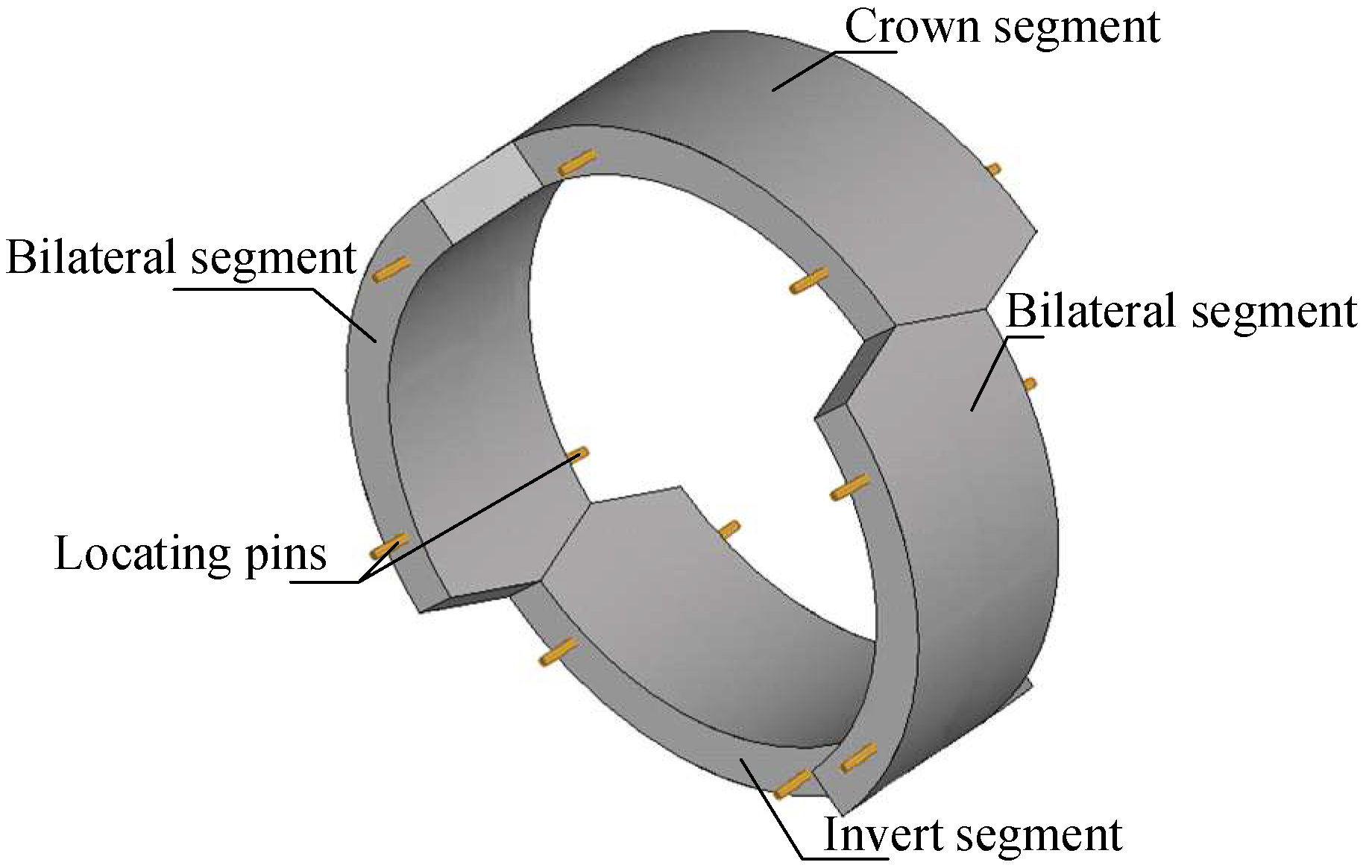
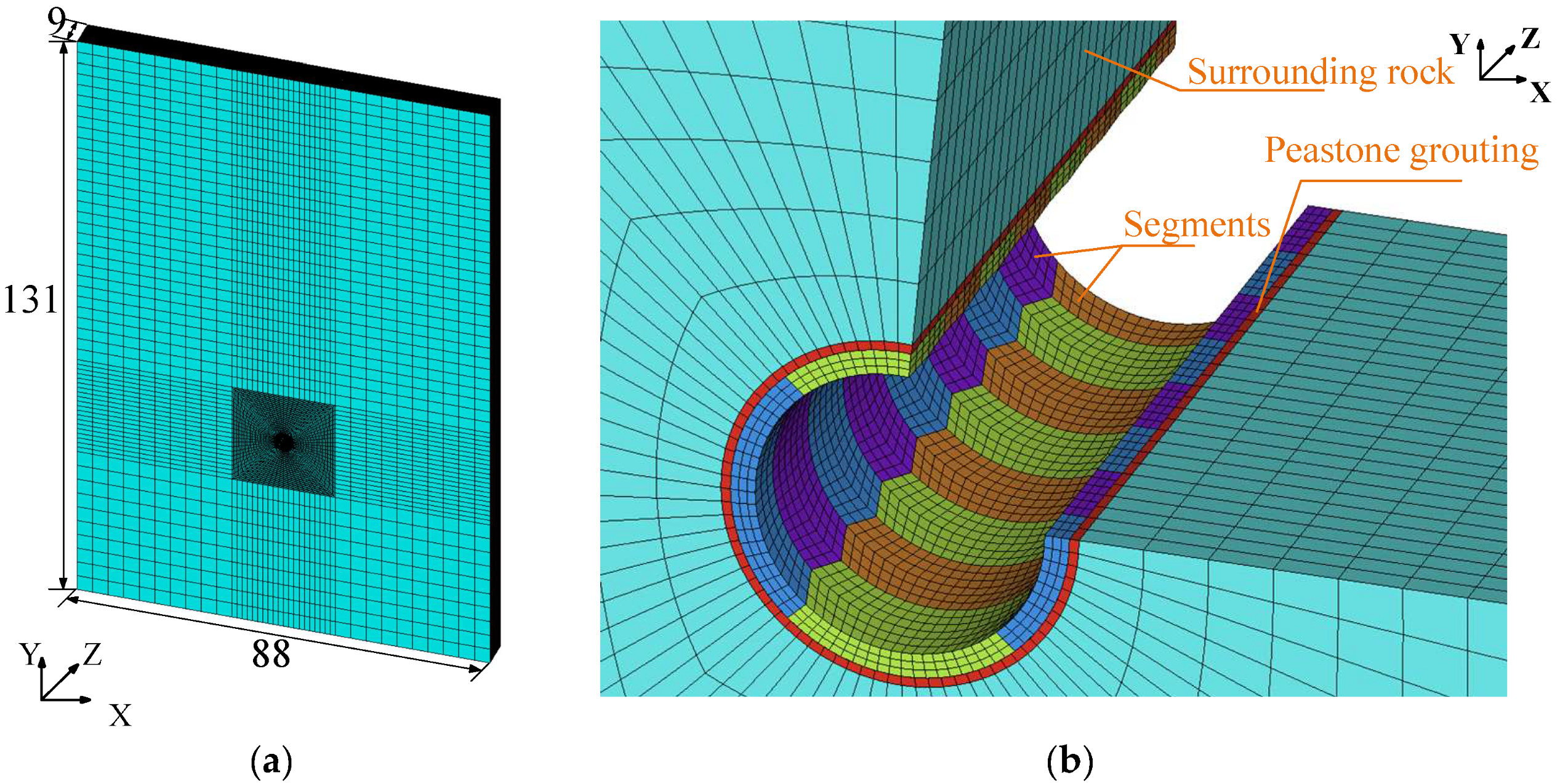
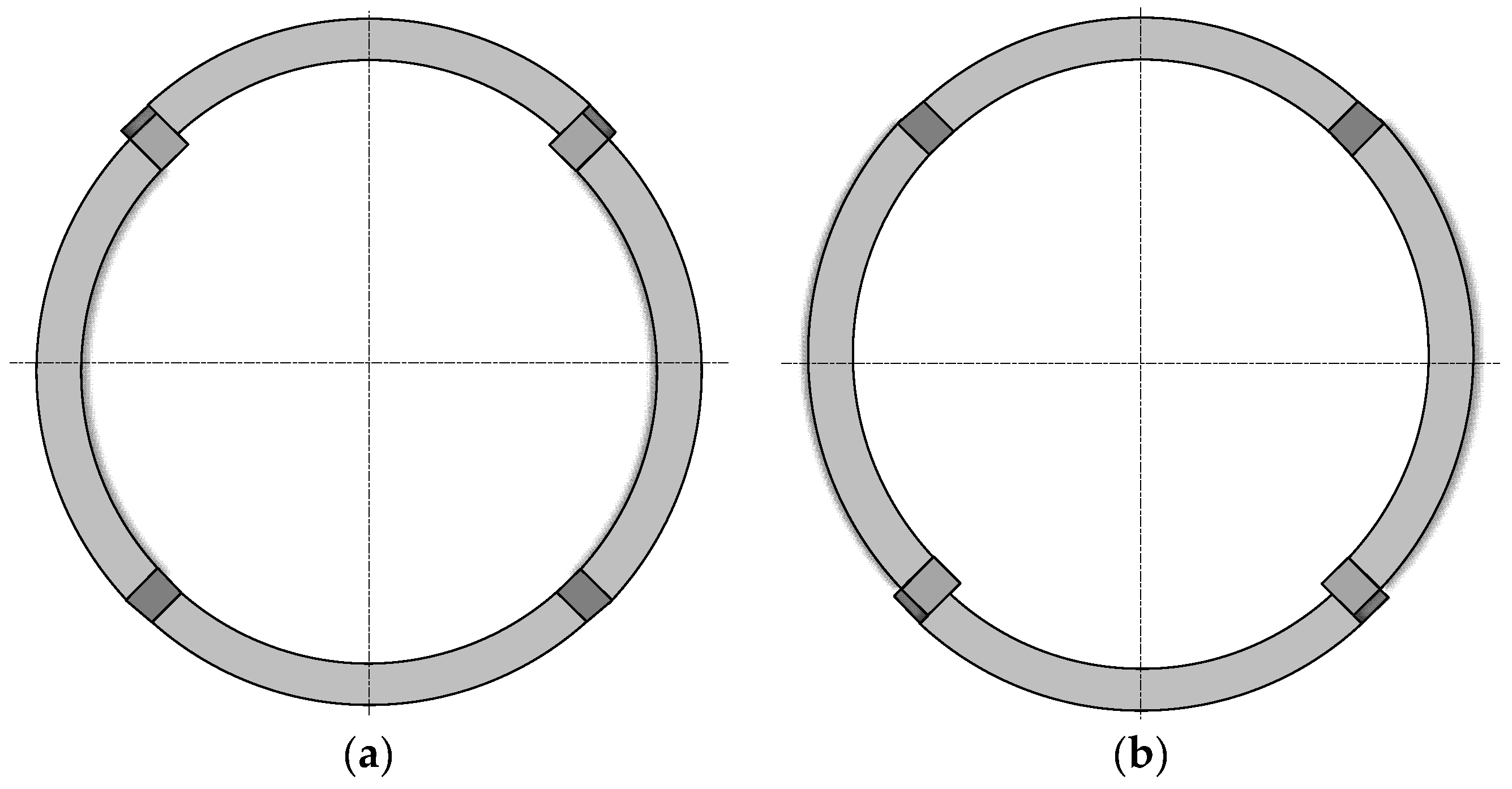
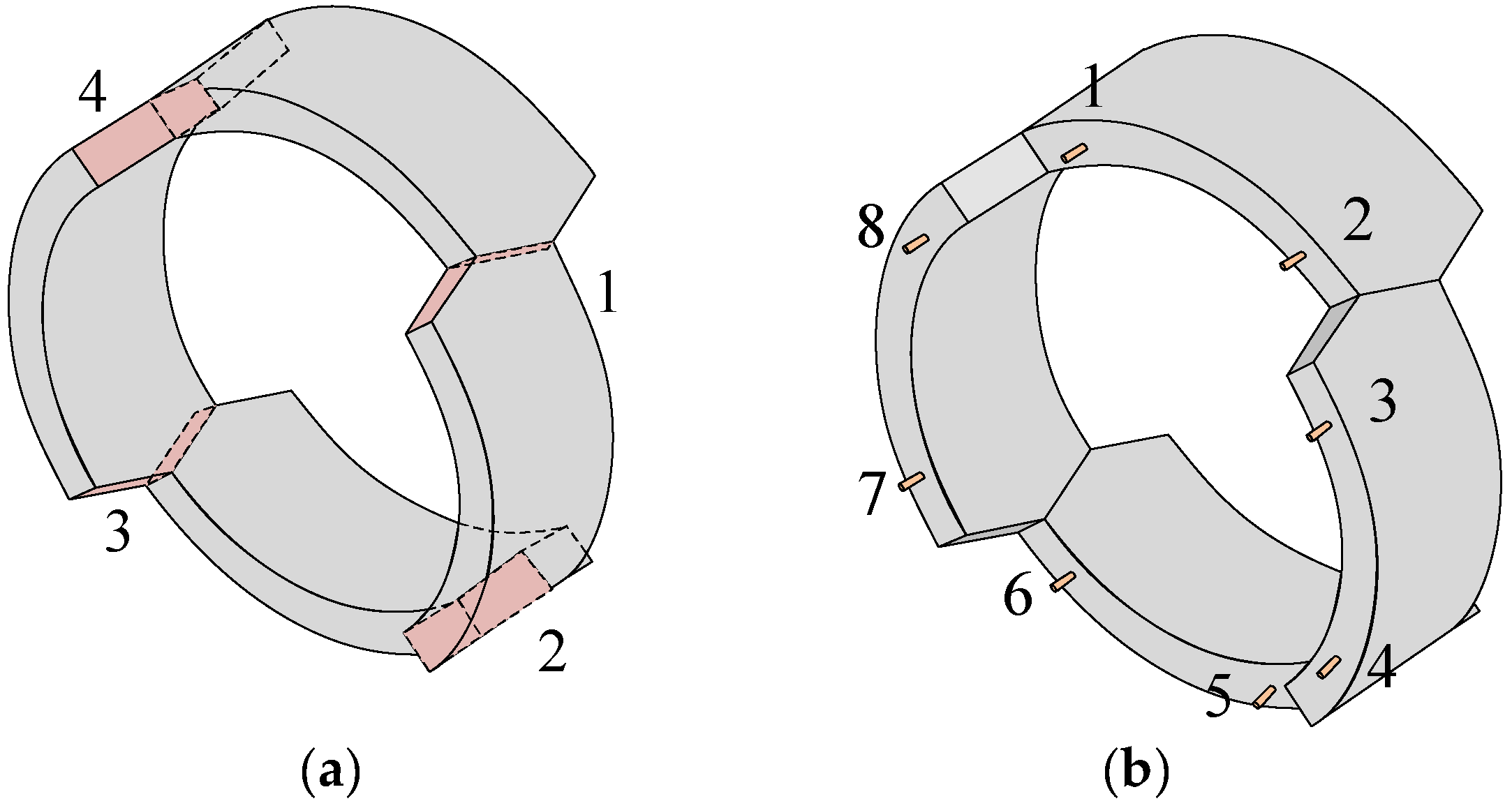




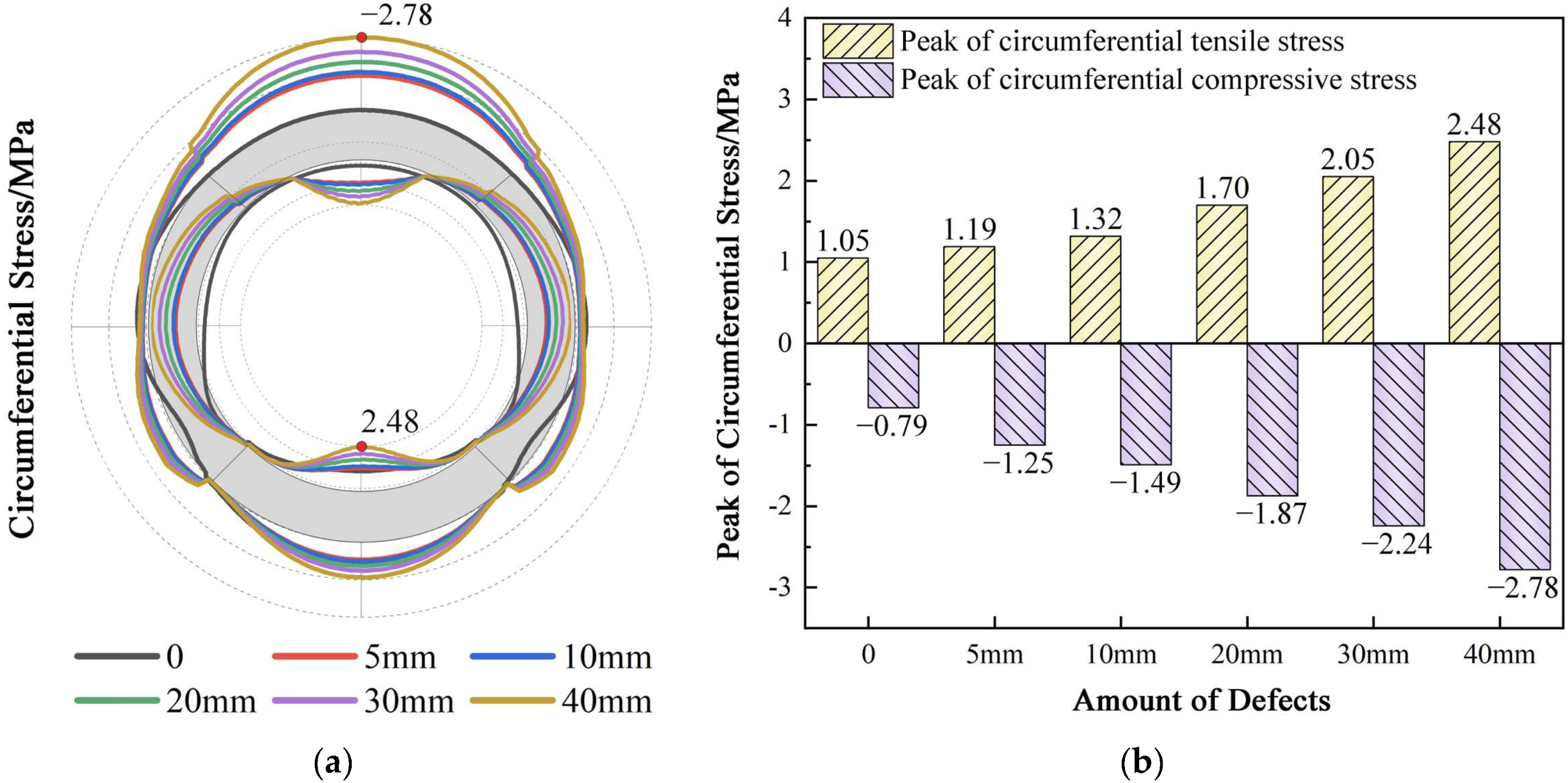
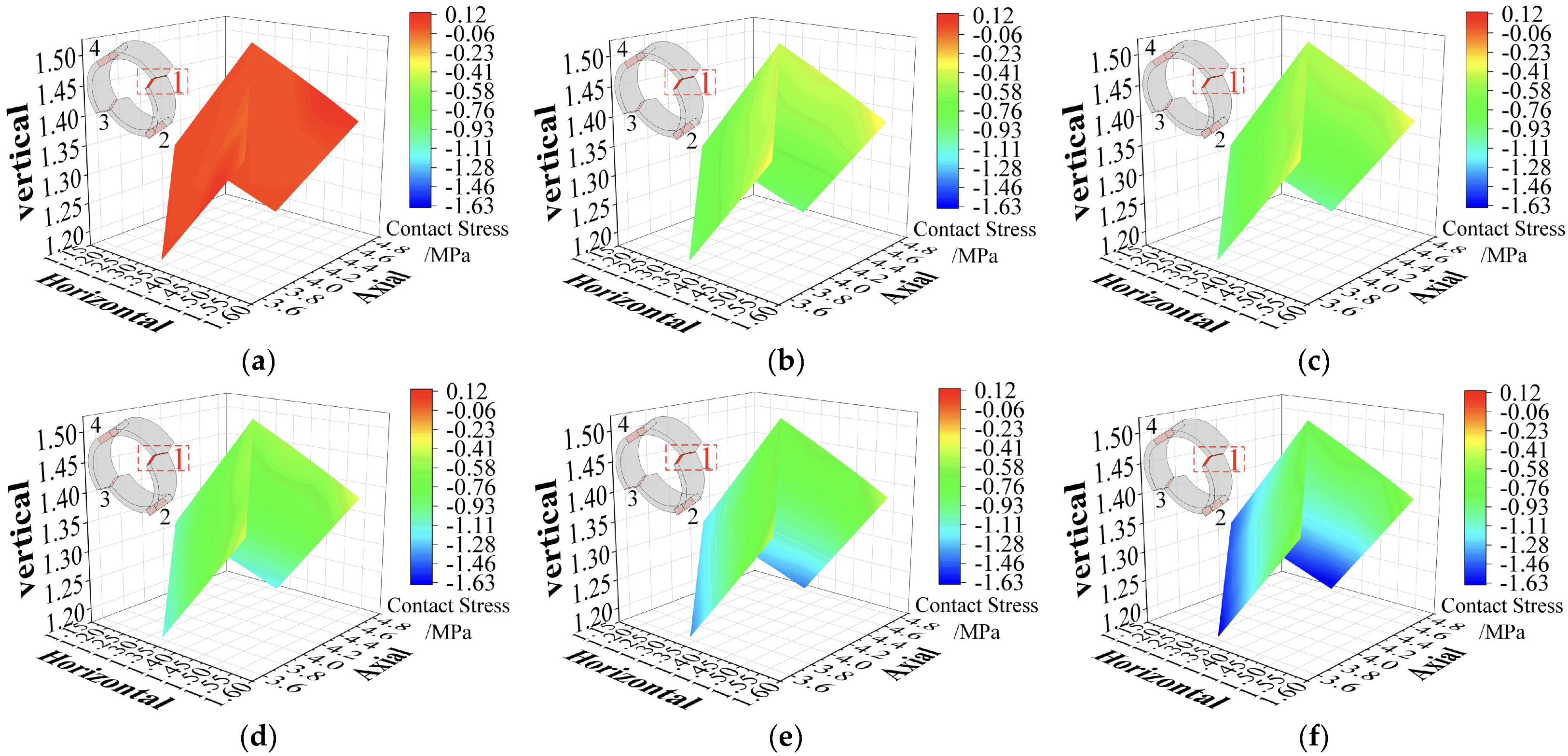
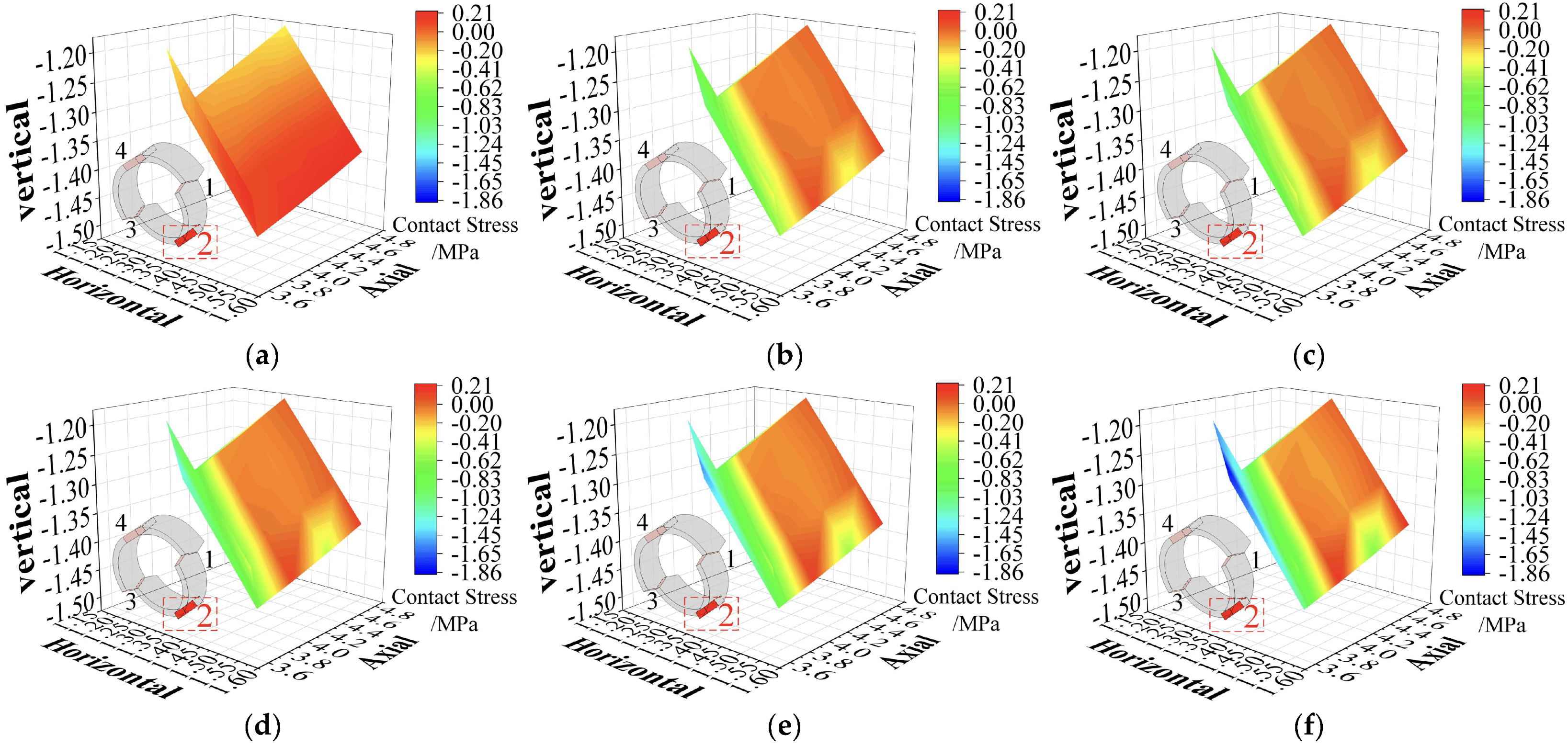
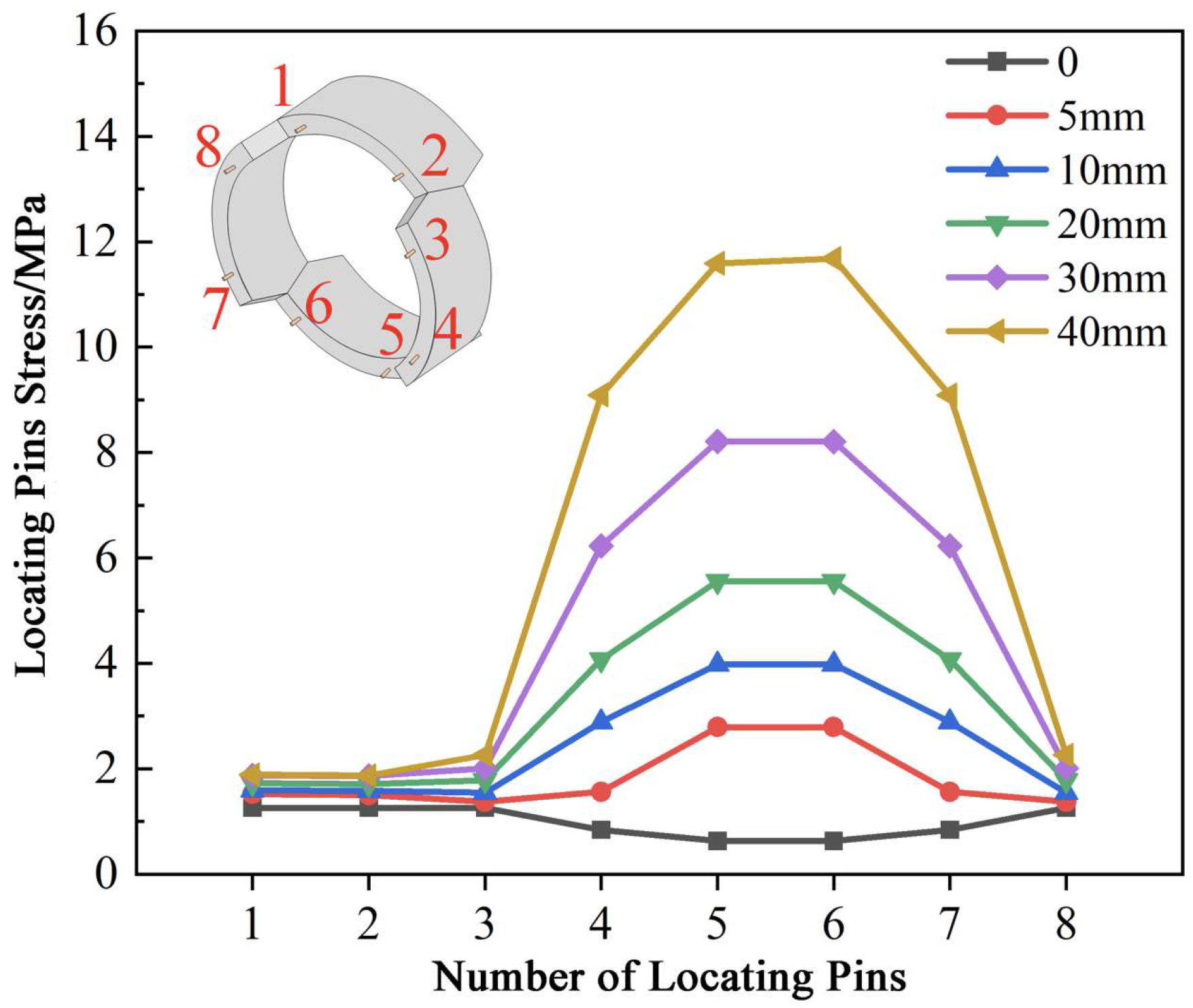
| Type of Material | Compressive Strength (MPa) | Tensile Strength (MPa) | Deformation Modulus (GPa) | Poisson’s Ratio | Density (kg/m3) |
|---|---|---|---|---|---|
| C50 concrete | 32.4 | 2.64 | 34.5 | 0.1 | 2450 |
| Peastone grouting | 8.0 | - | 3.0 | 0.27 | 1700 |
| Locating pin | - | 310 | 210 | 0.3 | 7800 |
| Type of Surrounding Rock | Density (kg/m3) | Internal Friction Angle (°) | Cohesion (MPa) | Deformation Modulus (GPa) | Poisson’s Ratio |
|---|---|---|---|---|---|
| V | 2000 | 20 | 0.08 | 0.5 | 0.40 |
| Working Condition | Defect Type | Segment Misalignment Size (mm) |
|---|---|---|
| 1 | No defect | 0 |
| 2 | Misaligned crown segment | 5 |
| 3 | 10 | |
| 4 | 20 | |
| 5 | 30 | |
| 6 | 40 | |
| 7 | Misaligned invert segment | 5 |
| 8 | 10 | |
| 9 | 20 | |
| 10 | 30 | |
| 11 | 40 |
Disclaimer/Publisher’s Note: The statements, opinions and data contained in all publications are solely those of the individual author(s) and contributor(s) and not of MDPI and/or the editor(s). MDPI and/or the editor(s) disclaim responsibility for any injury to people or property resulting from any ideas, methods, instructions or products referred to in the content. |
© 2024 by the authors. Licensee MDPI, Basel, Switzerland. This article is an open access article distributed under the terms and conditions of the Creative Commons Attribution (CC BY) license (https://creativecommons.org/licenses/by/4.0/).
Share and Cite
Li, F.; Si, P.; He, Y.; Wang, H.; Zhang, Z.; Zhao, S. Numerical Analysis of the Single-Directionally Misaligned Segment Behavior of Hydraulic TBM Tunnel. Buildings 2024, 14, 2198. https://doi.org/10.3390/buildings14072198
Li F, Si P, He Y, Wang H, Zhang Z, Zhao S. Numerical Analysis of the Single-Directionally Misaligned Segment Behavior of Hydraulic TBM Tunnel. Buildings. 2024; 14(7):2198. https://doi.org/10.3390/buildings14072198
Chicago/Turabian StyleLi, Fenglan, Pengcheng Si, Yintao He, Hui Wang, Zhixiao Zhang, and Shunbo Zhao. 2024. "Numerical Analysis of the Single-Directionally Misaligned Segment Behavior of Hydraulic TBM Tunnel" Buildings 14, no. 7: 2198. https://doi.org/10.3390/buildings14072198





